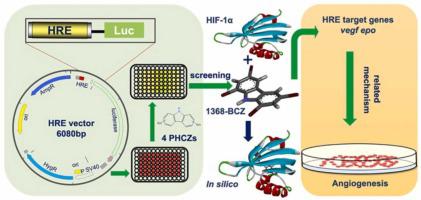Journal of Hazardous Materials ( IF 12.2 ) Pub Date : 2022-03-16 , DOI: 10.1016/j.jhazmat.2022.128718 Tong Xu 1 , Xiaoxu Hu 1 , Guanglei Yang 1 , Yiyun Liu 1 , Qian Zhang 2 , Shuyuan Yu 3 , Guomin Chen 3 , Yunping Li 4 , Rui Sha 1 , Yangsheng Chen 1 , Heidi Qunhui Xie 1 , Tai L Guo 5 , Li Xu 1 , Bin Zhao 6

|
The dioxin-like substances polyhalogenated carbazoles (PHCZs) may trigger the aryl hydrocarbon receptor (AhR) signaling pathway. Although the crosstalk between AhR and the hypoxia inducible factor-1 (HIF-1) pathways is generally believed to occur, the exact mechanisms of the HIF-1 pathway in PHCZ toxicity have not been determined. We aimed to elucidate the effect of PHCZs on the HIF-1 pathway and its involvement in the regulation of target genes of HIF-1. Herein, we employed human HepG2 cells transiently transfected with a hypoxia response element (HRE) luciferase reporter to identify PHCZs that could influence HIF-1 pathway. We found that exposure to one of the four selected PHCZs, specifically 1,3,6,8-tetrabromo-9H-carbazole (1368-BCZ), induced a significant enhancement of the activity of HRE activity. In silico data supported 1368-BCZ-induced HIF-1α activity preferentially. Moreover, 1368-BCZ significantly upregulated the expression of HIF-1 target genes, including endothelial growth factor (VEGF) and erythropoietin. Importantly, the stimulated secretion of VEGF by 1368-BCZ promoted the angiogenesis in human umbilical vein endothelial cells. Therefore, the present experimental and computational studies provide new and direct evidence of 1368-BCZ - HIF-1 interaction, which sheds light on the HIF-mediated cardiovascular toxicity and allows a knowledge-based risk assessment of emerging pollutants.
中文翻译:

HIF-1α/VEGF 通路介导 1,3,6,8-四溴-9H-咔唑诱导的血管生成:一种新兴污染物的潜在血管毒性
二恶英类物质多卤咔唑(PHCZs)可能触发芳烃受体(AhR)信号通路。尽管通常认为 AhR 和缺氧诱导因子-1 (HIF-1) 通路之间存在串扰,但 HIF-1 通路在 PHCZ 毒性中的确切机制尚未确定。我们旨在阐明 PHCZs 对 HIF-1 通路的影响及其对 HIF-1 靶基因调控的参与。在这里,我们使用用缺氧反应元件 (HRE) 荧光素酶报告基因瞬时转染的人类 HepG2 细胞来鉴定可能影响 HIF-1 通路的 PHCZ。我们发现暴露于四种选定的 PHCZ 中的一种,特别是 1,3,6,8-四溴-9H-咔唑 (1368-BCZ),会显着增强 HRE 的活性。计算机数据优先支持 1368-BCZ 诱导的 HIF-1α 活性。此外,1368-BCZ 显着上调 HIF-1 靶基因的表达,包括内皮生长因子 (VEGF) 和促红细胞生成素。重要的是,1368-BCZ 刺激的 VEGF 分泌促进了人脐静脉内皮细胞的血管生成。因此,目前的实验和计算研究为 1368-BCZ - HIF-1 相互作用提供了新的直接证据,这揭示了 HIF 介导的心血管毒性,并允许对新兴污染物进行基于知识的风险评估。































 京公网安备 11010802027423号
京公网安备 11010802027423号